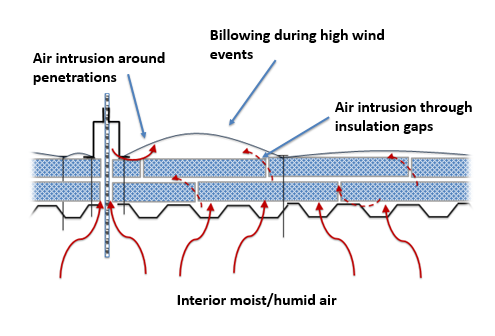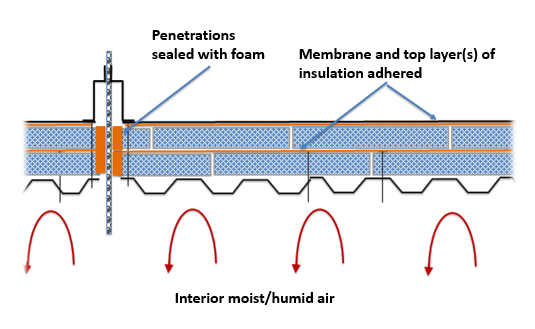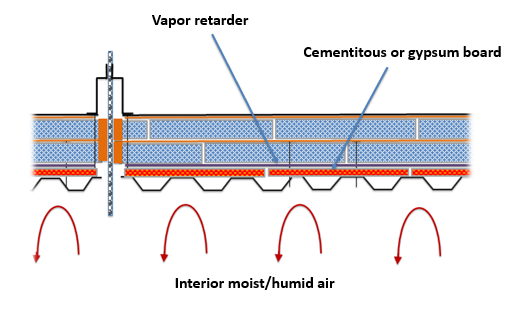Low-Slope Roofing—Air Barriers and Vapor Retarders
Vapor Retarders
Vapor retarders are commonly used in low-slope roof assemblies to perform two functions:
- Limiting airflow into the roof assembly. Minimizing the movement of air into the roof assembly, called air intrusion, reduces the movement of moisture-laden air in a building’s interior from moving into the roof assembly where condensation may be a risk.
- Reducing diffusion of moisture vapor through roof materials. Generally speaking, the risk would be higher when a building’s interior humidity conditions are expected to be relatively high, and/or the building is located in a cold climate. Additionally, vapor retarders can be used to help address moisture issues that can occur with structural concrete decks.
Locating the Vapor Retarder
To determine where a vapor retarder should be located, there are a number of steps that should be taken. Many on-line resources and guides to achieving this are available. However, in summary, the key steps are as follows:
- First, ensure that the design has limited the potential air intrusion, or air flow, into and out of the assembly being considered for condensation risk. Otherwise condensation from air flow has the potential to far exceed the amount of moisture from a steady-state calculation, such as a dewpoint or hygrothermal analysis.
- Determine the winter interior design dry bulb temperature. This design value is essentially the temperature that the building’s interior will be set at during the winter months. The information typically can be obtained from the HVAC system designer. However, for existing buildings, the building maintenance engineer is a possible resource.
- Obtain the winter exterior design dry bulb temperature. Design values can be found in Chapter 14—Climatic Design Information of the ASHRAE Handbook—Fundamentals; or in the Appendix of The NRCA Roofing Manual: Architectural Metal Flashing and Condensation and Air Leakage Control.
- Draw the roof assembly to a practical scale.
- Determine the roof assembly’s overall R-value and the values of the constituent components. Thermal properties of roofing materials can be obtained from manufacturers’ product literature. Other possible sources include: Chapter 26—Thermal Transmission Data of the ASHRAE Handbook—Fundamentals; or the Appendix of The NRCA Roofing Manual: Architectural Metal Flashing and Condensation and Air Leakage Control.
- Calculate the amount of heat loss occurring at the top surface of each material/layer. The temperature at the top of each material is lower as we move from interior to exterior. The heat loss formula for temperature drop (Td) is:
Td = Ti - [(R/RT) x ΔT]
where:
Td = temperature drop (temperature at top surface of material), degrees Fahrenheit
Ti = design inside (interior side) temperature, degrees Fahrenheit
ΔT = (winter interior design dry bulb temperature) - (exterior design dry bulb temperature)
R = cumulative R-values of materials - Plot the temperatures at each material interface as shown in the following schematic:

Note that in practice, for accuracy it is important to take into account the R-values of the air films above and below the assembly.
From the analysis, it should be clear that when specified, a vapor retarder would be placed at a location below the location of the dew point.
Material Selection Criteria
When selecting a vapor retarder material, it is important to consider the perm rating. This provides a measure of how much moisture can diffuse through the material. As will be discussed later, it can be important to ensure that some moisture transport is possible so that trapped moisture can escape. This could be from a small leak or from precipitation during construction. There are three classes of vapor retarder materials, as shown here:
| Class | Definition |
| I | 0.1 perm or less |
| II | Greater than 0.1 perm to less than 1.0 perm |
| III | Greater than 1.0 perm to less than 10 perm |
From a designer’s perspective, if a vapor retarder is needed, which class should be used? If a Class I vapor retarder is used, the concern is that any moisture (e.g., construction moisture due to installation methods, weather, etc.) that enters a roof system won’t be able to dry out. It’s often a good idea to select a vapor retarder that will allow some amount of drying from diffusion. Exceptions to this idea include roofs over indoor swimming pools and other high-humidity producing activities or processes. Another exception is a Class I vapor retarder should be installed over a new concrete deck to prevent the moisture in the concrete from drying into the roof system.
Vapor Retarders Material Types
In roof assemblies there are a number of choices of possible materials. Two categories of vapor retarders are worth singling out, bituminous and non-bituminous. Bituminous-based vapor retarders are the most common and include self-adhering modified bitumen sheets, and adhered smooth-surfaced APP or SBS-modified bitumen sheets. Additionally, there are built-up bituminous vapor retarders which are generally composed of one or two layers of asphalt felts or glass fiber mats applied with two or three moppings of hot asphalt.
Non-bituminous-based vapor retarders include plastic sheets, plastic laminates, kraft paper, kraft laminates and aluminum foil laminates. Some of these come with a self-adhering peel and stick backing and are generally self-sealing around fasteners. It is important to remember that vapor retarders, being installed lower down in a roof assembly, are frequently penetrated by fasteners from the insulation and membranes above. The adhesives used are designed to meet a self-seal test described in ASTM D1790.
There are non-bituminous types of vapor retarders that are installed loose-laid or adhered using a compatible adhesive to adhere the sheets to the roof deck or substrate. Black poly sheet, technically 6 mil polyethylene often referred to as Visqueen, is often used as a vapor retarder in residential crawl spaces. However, its use in roof systems is generally not recommended for several reasons:
- It does not self-seal around fasteners that penetrate through it. Vapor retarders are designed to meet a self-seal test described in ASTM D1970. Specifiers should always check that this is part of the material specification.
- Polyethylene is notoriously difficult to adhere to, which makes flashing and sealing around penetrations very difficult and unlikely to last.
- 6 mil polyethylene is essentially impermeable which means that any leak in the roof covering will let in water that can’t escape. Also, if some water has been present when the roof was closed up, from dew or light rain during the previous night, it will not be able to escape. Properly specified vapor retarders typically have some degree of permeability that will allow for migration of water from within a roof assembly downwards. The only exception to this would be for a building with a very high interior humidity or a concrete roof deck when it might be advisable to have a vapor retarder with essentially no permeability.
Installation of the Vapor Retarder
Using the complete roof assembly shown earlier as an example, any vapor retarder would be placed below the bottom layer of insulation. The analysis suggests that the dew point is somewhere within the bottom thermal insulation layer, meaning that condensation could possibly occur between insulation boards. Therefore, in this example, a vapor retarder would be placed directly over the deck. However, such a system may not have code approval as a roof system. So, many designs are based on installation of the vapor retarder over a cementitious or gypsum board attached over a steel deck. This is shown in progress below:

Is a Vapor Retarder Always Needed in Cold Climates?
Whether or not to add a vapor retarder to a roof assembly design is somewhat complex and can be a judgement call based on the designer’s experience. The designer should take into account factors such as:
- What is the building’s continuous air barrier strategy?
- The building’s intended use—for example interior swimming pools will add large amounts of moisture to the internal air and significantly raise the risk of condensation within the building enclosure. While this might be an obvious example, multi-family units can also have high humidity levels due to cooking etc. Some industrial operations (e.g., commercial laundromats) could also add large amounts of moisture to the interior air.
- The local climate and the designer’s experience—while some regions experience sub-freezing winter temperatures, some designers may have not seen condensation occurring when not using vapor retarders. Often a combination of the local climate, building use, and the roof assembly typically used can lead to quite low condensation risk. The impact of the overall roof assembly is discussed in the next section.
Do Vapor Retarders Have a Role in the South?
From the discussion so far, it could appear that vapor retarders are only considered for buildings in the north, i.e in climates that have cold winters. However, there is another situation where vapor retarders can be used in more southerly locations. Consider buildings with large footprints that have poured concrete floors. Warehouses and large retail developments would be examples. In some cases, the building is closed up before the poured concrete floor has dried. This allows other trades to commence work during construction but it can lead to very high interior humidity levels. It is not unusual for designers and developers of such buildings to include a vapor retarder in the roof assembly design. Once the floor has dried out, many months later, its role is minimal but it can prevent condensation and related damage during construction.
A Closer Look at the Vapor Control Layer
Returning to the concept of a complete roof introduced at the beginning of this article, using a vapor retarder is one of a few ways to control vapor and moisture movement from air intrusion. For buildings with a minimal risk of condensation, mechanically attached assemblies might be a viable approach. However, the following schematic shows some of the risks associated with such a design:

Even though the use of double layers of polyiso insulation with staggered joints, as first required by the 2018 IECC, limits the movement of air upwards through a roof assembly, it doesn’t prevent it. Also, penetrations that are not adequately sealed can allow for air movement. During high wind events, it is not uncommon to observe billowing of single-ply membranes installed in this way. The billowing actively draws interior air up into the assembly, which can result in the moisture carried with warm interior air condensing on the underside of the cold roof membrane.
By adhering the membrane and top insulation layer(s) and sealing around penetrations, air flow can be significantly reduced.

This schematic might suggest that a vapor retarder isn’t ever required. However, there are limits to the success of this approach:
- While adhered systems do significantly limit the movement of humid air up into the roof assembly, there can be issues at the edges. Termination to the walls can be done more successfully with a vapor retarder as will be discussed later.
- Depending on the type of adhesive used and the installation quality, there can still be a condensation risk in buildings with higher levels of moisture.
For those buildings and locations where moisture risks are high, the best approach is to install a vapor barrier. While it can be installed between insulation layers, a common practice is to first install a cementitious or gypsum board which acts as a substrate for a vapor retarder. This is shown in the following schematic.










